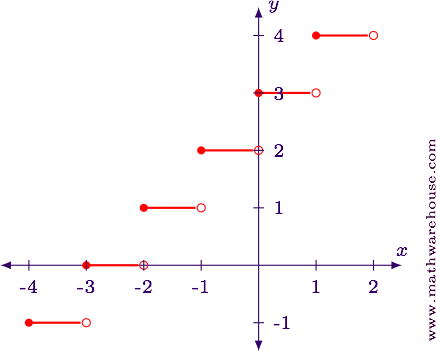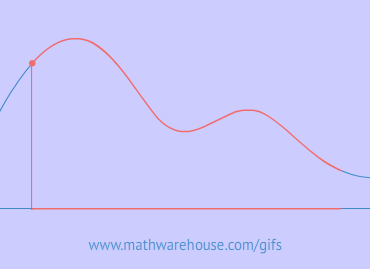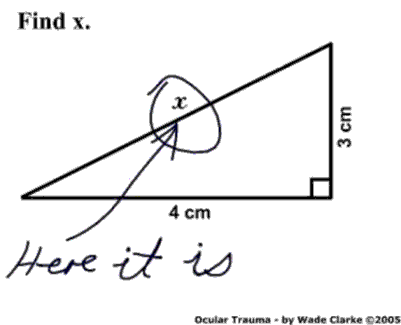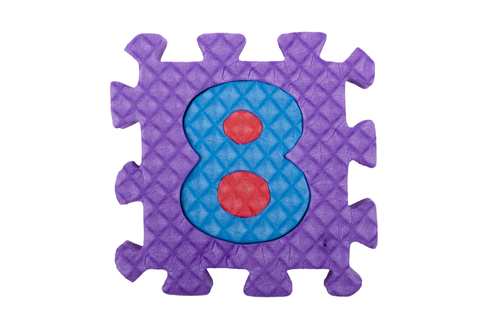Examining the number line near 12 we see that $$\lfloor 12.5\rfloor = 12$$.

Examining the number line near -6.7 we see that $$\lfloor -6.7\rfloor = -7$$.

Since 50 is an integer, we know $$\lfloor 50\rfloor = 50$$.
Using a calculator, we can determine that $$\pi$$ is approximately 3.14. Examining the number line near this point we see that $$\lfloor \pi\rfloor = 3$$.

Using a calculator, we can determine that $$\frac{23}{19}$$ is approximately 1.21. Examining the number line near this point we see that $$\left\lfloor \frac{23}{19}\right\rfloor = 1$$.

Using a calculator, we can determine that $$\sqrt 2$$ is approximately 1.41. Examining the number line near this point we see that $$\left\lfloor \sqrt 2\right\rfloor = 1$$.

As in the previous example, we can go about this by constructing a table, or interpreting the function in terms of transformations. This solution will do both.
TABLE
$$ \begin{array}{|c|c|c|} \hline x & 2x & \lfloor 2x \rfloor \\ \hline -0.75 & -1.5 & -2\\ -0.5 & -1 & -1\\ -0.25 & -0.5 & -1\\ 0 & 0 & 0\\ 0.25 & 0.5 & 0\\ 0.5 & 1 & 1\\ 0.75 & 1.5 & 1\\ 1 & 2 & 2\\ 1.25 & 2.5 & 2\\ \hline \end{array} $$
In this case, we see that every time $$x$$ is a multiple of 0.5 the function jumps to the next higher integer.
TRANSFORMATION
We can interpret $$y = \lfloor 2x \rfloor$$ as a horizontal compression by a factor of 2. That is, each of the $$x$$-values from $$y = \lfloor x\rfloor$$ gets cut in half, but the $$y$$-values stay the same.

We will examine this function using both a table, and then as a transformation of functions.
TABLE
$$ \begin{array}{|c|c|c|} \hline x & 1.5x & \lfloor 1.5x \rfloor \\ \hline -1 & -1.5 & -2\\ -2/3 & -1 & -1\\ -1/3 & -0.5 & -1\\ 0 & 0 & 0\\ 1/3 & 0.5 & 0\\ 2/3 & 1 & 1\\ 1 & 1.5 & 1\\ 4/3 & 2 & 2\\ 5/3 & 2.5 & 2\\ 2 & 3 & 3\\ \hline \end{array} $$
The table shows that the function increases every multiple of 2/3.
TRANSFORMATION
Since the variable $$x$$ is being multiplied by 1.5, we know that the graph of $$y = \lfloor x\rfloor$$ is being compressed horizontally.

We will examine this function using both a table, and then as a transformation of functions.
TABLE
$$ \begin{array}{|c|c|c|} \hline x & -0.25x & \lfloor -0.25x \rfloor \\ \hline -4 & 1 & 1\\ -3 & 0.75 & 0\\ -2 & 0.5 & 0\\ -1 & 0.25 & 0\\ 0 & 0 & 0\\ 1 & -0.25 & -1\\ 2 & -0.5 & -1\\ 3 & -0.75 & -1\\ 4 & -1 & -1\\ \hline \end{array} $$
The table shows that the function increases every multiple of 4.
TRANSFORMATION
Since the variable $$x$$ is being multiplied by 0.25, we know the function is being horizontally stretched by a factor of 4. Since the coefficient is negative, the function is also being reflected about the $$y$$-axis.

We will examine this function using both a table, and then as a transformation of functions.
TABLE
$$ \begin{array}{|c|c|c|} \hline x & \lfloor x \rfloor & 2\lfloor x \rfloor\\ \hline -1.5 & -2 & -4\\ -1 & -1 & -2\\ -0.5 & -1 & -2\\ 0 & 0 & 0\\ 0.5 & 0 & 0\\ 1 & 1 & 2\\ 1.5 & 1 & 2\\ 2 & 2 & 4\\ \hline \end{array} $$
The table shows that the function increases by 2 every time $$x$$ increases by 1.
TRANSFORMATIONS
The function has a vertical stretch by 2.

We will examine this function using both a table, and then as a transformation of functions.
TABLE
$$ \begin{array}{|c|c|c|} \hline x & x + 3 & \lfloor x + 3\rfloor \\ \hline -4 & -1 & -1\\ -3.5 & -0.5 & -1\\ -3 & 0 & 0\\ -2.5 & -0.5 & 0\\ -2 & 1 & 1\\ -1.5 & 1.5 & 1\\ -1 & 2 & 2\\ -0.5 & 2.5 & 2\\ 0 & 3 & 3\\ 0.5 & 3.5 & 3\\ 1 & 4 & 4\\ \hline \end{array} $$
The table shows us that the function increases each time $$x$$ is an integer.
TRANSFORMATIONS
The function $$y = \lfloor x + 3\rfloor$$ is a shift to the left by 3 units of the function

We will examine this function using both a table, and then as a transformation of functions.
TABLE
$$ \begin{array}{|c|c|c|c|} \hline x & 2 - x & \lfloor 2 - x \rfloor & -0.75\lfloor 2 - x \rfloor\\ \hline -2.5 & 4.5 & 4 & 3\\ -2 & 4 & 4 & 3\\ -1.5 & 3.5 & 3 & 2.25\\ -1 & 3 & 3 & 2.25\\ -0.5 & 2.5 & 2 & 1.5\\ 0 & 2 & 2 & 1.5\\ 0.5 & 1.5 & 1 & 0.75\\ 1 & 1 & 1 & 0.75\\ 1.5 & 0.5 & 0 & 0\\ 2 & 0 & 0 & 0\\ 2.5 & -0.5 & -1 & -0.75\\ \hline \end{array} $$
The table shows that the function changes value just after $$x$$ is an integer. Each time the function changes value it decreases by 0.75.
TRANSFORMATIONS
The function $$y = -0.75\lfloor 2 - x\rfloor$$ consists of four different transformations.
- A vertical reflection (over the $$x$$-axis).
- A horizontal reflection (over the $$y$$-axis).
- A vertical compression of 0.75.
- A horizontal shift by 2 units to the right.

Since the reciprocal function $$y = \frac 1 x$$ is not a standard transformation, we will just use a table to understand the behavior of this function.
TABLE
$$ \begin{array}{|c|c|c|} \hline x & 1/x & \left\lfloor 1/x \right\rfloor \\ \hline -4 & -1/4 & -1\\ -3 & -1/3 & -1\\ -2 & -1/2 & -1\\ -1 & -1 & -1\\ -1/2 & -2 & -2\\ -1/3 & -3 & -3\\ -1/4 & -4 & -4\\ 0 & \mbox{undefined} & -\\ 1/4 & 4 & 4\\ 1/3 & 3 & 3\\ 1/2 & 2 & 2\\ 1 & 1 & 1\\ 2 & 1/2 & 0\\ 3 & 1/3 & 0\\ 4 & 1/4 & 0\\ \hline \end{array} $$

Since the reciprocal function $$y = \frac 1 x$$ is not a standard transformation, we will just use a table to understand the behavior of this function.
TABLE
$$ \begin{array}{|c|c|c|} \hline x & \lfloor x\rfloor & \frac 1 {\lfloor x \rfloor} \\ \hline -4 & -4 & -1/4\\ -3 & -3 & -1/3\\ -2 & -2 & -1/2\\ -1 & -1 & -1\\ 0 & 0 & \mbox{undefined}\\ 1 & 1 & 1\\ 2 & 2 & 1/2\\ 3 & 3 & 1/3\\ 4 & 4 & 1/4\\ \hline \end{array} $$

We'll examine the behavior of this function by constructing a table of values.
TABLE
$$ \begin{array}{|c|c|c|} \hline x & x^2 & \lfloor x^2\rfloor \\ \hline -2 & 4 & 4\\ -\sqrt 3 & 3 & 3\\ -\sqrt 2 & 2 & 2\\ -1 & 1 & 1\\ -0.5 & 0.25 & 0\\ 0 & 0 & 0\\ 0.5 & 0.25 & 0\\ 1 & 1 & 1\\ \sqrt 2 & 2 & 2\\ \sqrt 3 & 3 & 3\\ 2 & 4 & 4\\ \hline \end{array} $$

We'll examine the behavior of this function by constructing a table of values.
TABLE
$$ \begin{array}{|c|c|c|} \hline x & \lfloor x\rfloor & \lfloor x\rfloor^2\\ \hline -3 & -3 & 9\\ -2.5 & -3 & 9\\ -2 & -2 & 4\\ -1.5 & -2 & 4\\ -1 & -1 & 1\\ -0.5 & -1 & 1\\ 0 & 0 & 0\\ 0.5 & 0 & 0\\ 1 & 1 & 1\\ 1.5 & 1 & 1\\ 2 & 2 & 4\\ 2.5 & 2 & 4\\ 3 & 3 & 9\\ \hline \end{array} $$

Let's build a table of values to understand this function.
TABLE
$$ \begin{array}{|c|c|c|} \hline x & x \lfloor x\rfloor & x - \lfloor x\rfloor\\ \hline -1 & -1 & 0\\ -0.8 & -1 & 0.2\\ -0.6 & -1 & 0.4\\ -0.4 & -1 & 0.6\\ -0.2 & -1 & 0.8\\ 0 & 0 & 0\\ 0.2 & 0 & 0.2\\ 0.4 & 0 & 0.4\\ 0.6 & 0 & 0.6\\ 0.8 & 0 & 0.8\\ 1 & 1 & 0\\ 1.2 & 1 & 0.2\\ 1.4 & 1 & 0.4\\ \hline \end{array} $$
Each time $$x$$ is an integer, the function resets to 0. Then it slowly increases towards 1.

NOTE: This function is an example of a sawtooth wave. It is called this because, if we connect the points that are vertically aligned (see below) the graph resembles the teeth of a saw. Sawtooth waves play an important role in music and in representations of various wave forms in electronics and engineering.

Make a change of variable so the equation is easier to work with. Specifically, let $$u = \lfloor 1.3x\rfloor$$.
$$ \begin{align*} \lfloor 5.4 - \blue{\lfloor 1.3x \rfloor}\rfloor & = 17\\ \lfloor 5.4 - \blue{u}\rfloor & = 17\\ \end{align*} $$
Replace the equation with one of the inequalities discussed above. Then solve for $$u$$.
$$ \begin{align*}% 17 & \leq 5.4 - u < 18\\ 17 - 5.4 & \leq - u < 18-5.4\\ 11.6 & \leq - u < 12.6\\ -11.6 & \geq u > -12.6 \end{align*} $$
Since $$u$$ must be an integer, we know that $$u = -12$$.
Replace $$u$$ in the equation.
$$ \begin{align*}% \blue u & = -12\\ \blue{\lfloor 1.3x\rfloor} & = -12 \end{align*} $$
Replace the equation with one of the inequalities, then solve.
$$ \begin{align*} -12 & \leq 1.3x < -11\\[6pt] -\frac{12}{1.3} & \leq x < -\frac{11}{1.3}\\[6pt] -\frac{120}{13} & \leq x < -\frac{110}{13}\\[6pt] -9.2307 & \leq x < -8.4615 \end{align*} $$
In interval notation, $$x \in \left[-\frac{120}{13}, -\frac{110}{13}\right)$$.
Make a change of variable so the equation is easier to work with. Specifically, let $$\blue{u = \lfloor 2.5x-7.9\rfloor}$$.
$$ \begin{align*} \lfloor 3.2 + \blue{\lfloor 2.5x - 7.9\rfloor}\rfloor & = -5\\ \lfloor 3.2 + \blue{u}\rfloor & = -5 \end{align*} $$
Replace the equation with one of the inequalities, and solve for $$u$$.
$$ \begin{align*} -5 & \leq 3.2 + u < -4\\ -5 - 3.2 & \leq u < -4 - 3.2\\ -8.2 & \leq u < -7.2 \end{align*} $$
Since $$u$$ has to be an integer, we know $$u = -8$$.
Substitute the value of $$u$$ back into the equation.
$$ \begin{align*} \blue{u} & = -8\\ \blue{\lfloor 2.5x-7.9\rfloor} & = -8\\ \end{align*} $$
Replace the equation with one of the inequalities and solve for $$x$$.
$$ \begin{align*} -8 & \leq 2.5x-7.9 < -7\\ -8 + 7.9 & \leq 2.5x < -7 + 7.9\\ -0.1 & \leq 2.5x < 0.9\\ -\frac{0.1}{2.5} & \leq x < \frac{0.9}{2.5}\\[6pt] -\frac 1 {25} & \leq x < \frac 9 {25}\\[6pt] -0.04 & \leq x < 0.36 \end{align*} $$
In interval notation, $$x \in [-0.04, 0.36]$$.














